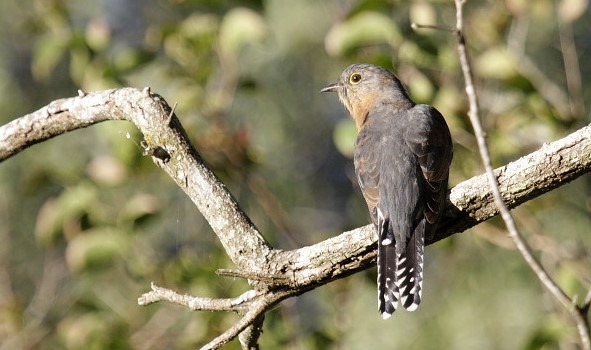A Fan-tailed Cuckoo (Cacomantis flabellzformis) observes its prey, such as caterpillars, moths, beetles, or other insects, from a perch, flies out and captures them, and then returns to the same perch to eat them. It belongs to the family Cuculidae.
The bird sits silently on a vantage stump, fence post, or bare branch, with its tail pointed downwards, resting silently on a vantage stump, fence post, or bare branch. A majority of its habitat is in the lower and middle storeys of rainforests, wet and dry sclerophyll forests, woodlands, coastal heaths, and treed areas found in cities and towns.

In order to pick up insects from the foliage, this bird flies out or hops along the ground to land a pounce. The bird undulates gracefully in flight on pointed wings, and when alighting, it lifts its tail for a short time to show off.
The males are generally solitary, and they rarely gather in groups of two to four members, unlike their female counterparts, who are usually solitary. The males probably defend territories when breeding, advertising their territories and themselves from a vantage point, making repeated plaintive calls, and feeding the females as part of the courtship ritual.
It is estimated that about 50 species of birds are parasitized by these cuckoos, of which the dominant species are dominating thornbills, scrubwrens, and fairywrens, particularly the Brown Thornbill. Likewise, the white-browed scrubwren is also commonly parasitized, as are the large-billed and Yellow-throated Scrubwrens, as well as the scrub-tit, redthroat, hylacolas, origma, and pilotbird.
In southwestern Australia, Fan-tailed Cuckoos typically do not migrate very far from one season to the next, but many of the birds in the southeastern region, particularly immatures, migrate considerable distances northwards during the nonbreeding winter months during which they are not breeding.

A lot of Tasmanian birds migrate to the mainland each year, and it is not known much about the distances cuckoos move, but at least some of these birds cross the Torres Strait to New Guinea and the Aru Islands, returning to the mainland each spring.
Ash-tailed Cuckoo is another name for it. A fan-tailed cuckoo measures between 250 and 270 mm in length. MALE: Upper parts are slate-grey; underparts are light to medium cinnamon-rufous, becoming paler on the abdomen and vent; throat and chin are greyish. On the underwing, there is a broad cream-white stripe, and on the shoulder, there is a white mark. Its tail is dark blue-black, with notches of white on its inner tail feathers that develop into bars on its outermost feathers.
The iris is chestnut brown to dark brown, with a yellow eye ring. The bill is black or blackish brown, the lower mandible is browner with a yellowish or flesh tone to the base, and the mouth is orange. Its feet are yellowish to olive-yellow, and its claws are dusky in color. The female is duller, especially the ventral surface, grayish with obscure barring to the abdomen and vent.

Immatures are generally dark brown, barred with dull, finely patterned red-brown and darker grey-brown. Ventrally, the throat and breast are dully mottled grey-brown and white, sometimes washed with russet; the belly is lighter or grayer in color. The wings are plain dark gray-brown, and the tail is black with a russet barring.
The iris is gray-brown; the eye ring is greenish-yellow. The lower mandible of the bill is brownish-black with a buff base. Dark pink to bright yellow feet Between immaturity and adulthood, birds exhibit varying plumages. In females, sub-adult plumage states seem to last longer, perhaps permanently.
The call of Fan-tailed Cuckoo is a rather slow or rapid descending plaintive trill repeated several times by males in advertisements, particularly from August to March; males also call in a high-pitched single whistle during courtship with a downward slur ending with an upward inflection. Only a female can make this plaintive cry. Nesting and breeding take place between August and January. Eggs are laid in domed nests by parasites.
A fan-tailed cuckoo lays one slightly lustrous egg, which is white to mauve, finely speckled, flecked, and spotted, particularly at its large end, with varying shades of chestnut, purple-brown, and lavender. The oval-shaped eggs measure 18-25 x 14-18 mm and are 18-25 x 14-18 mm in size. Approximately 14–15 days are required for incubation. It takes 16 to 17 days for the young to fledge.
A temperate forest, a subtropical or tropical mangrove forest, a subtropical or tropical moist montane forest, paddocks, orchards, or gardens are its natural habitats. As far as distribution is concerned, fan-tailed cuckoos are found from the Cape York Peninsula southward to southern Victoria and Tasmania and westward to the Eyre Peninsula and southwestern mainland. New Guinea to Fiji, New Caledonia, and occasionally New Zealand as a vagrant. Approximately six races exist, but only one is found in Australia.
Read More: Horsfield’s Bronze Cuckoo (Chrysococcyx basalis)







